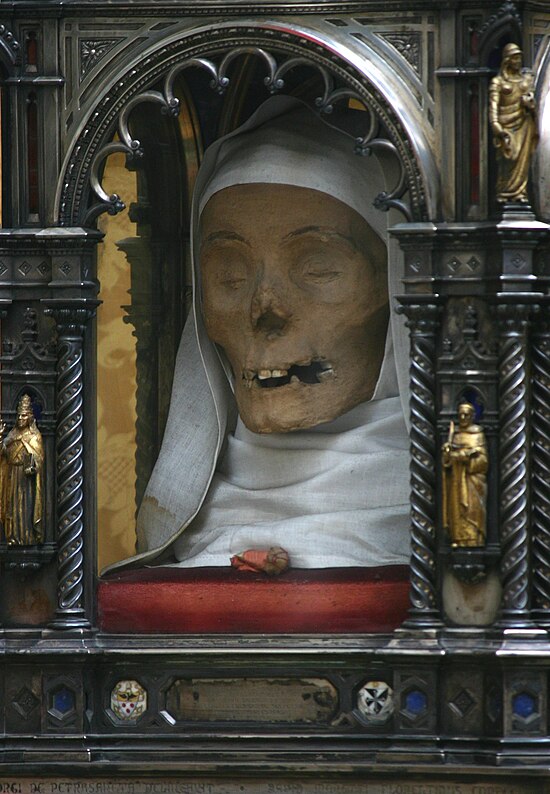The severed head is a common motif in films and television. Horror as a genre is full of beheadings, and heads mounted on pikes draw their authenticity from historical practices.
Heads made excellent display objects if you wanted to warn your enemies that you meant business. People recognise severed heads and only one conclusion can be drawn.
This person is dead.
This ultimately makes them so much more horrific than a severed foot or a section of an arm.
The head is also essential for our existence in the world. As Frances Larson points out, “[t]hanks to an impressive concentration of nerve endings and an unrivalled ability for expressive movement, our heads connect our inner selves to the outer world more intensely than any other part of our body” (2014: 12).
But what do they have to do with folklore?

Surprisingly, quite a lot. An obvious example would be Perseus cutting off Medusa’s head in Greek mythology. Then we have the severed head of Welsh hero Bran, allegedly buried beneath the Tower of London.
But there’s more to the folklore than these two examples, so let’s dig into severed heads in folklore!
The French Revolution
You can’t talk about decapitation and not mention the French Revolution. And you might wonder what it has to do with folklore.
As with any event whose impact is far-reaching and based on fear, several urban legends sprang up around the guillotine and her bloodlust. One tale appears several times, that of the ghostly woman who holds her decapitated head in place with a choker. A young man takes her home, only to discover her headlessness the following morning (Geroud 1992: 116).
Washington Irving (yep, he of the Headless Horseman fame) even wrote a short story about it, ‘The Adventures of a German Student’. He wrote it in 1824 so the French Revolution was still in living memory for some.
A severed head dispenses advice to Odin
Norse legends sometimes become difficult to follow when texts refer to a range of characters, often with the same name. Mimir is one such character. No one knows if Mimir is a single figure or two. But either way, one of the versions of Mimir guarded the well of wisdom. The other was equally wise, but the Aesir sent him to the Vanir as a hostage. The Vanir decapitated him and returned his head to the Aesir (Cunningham 2021).
Mourning the loss of a great advisor, Odin ended up with Mimir’s severed head. He preserved it using herbs, which also returned Mimir’s power of speech. Odin kept Mimir’s head by the well of wisdom so he could ask Mimir for counsel whenever he needed him (Winters 2020).
Mimir repaid Odin with the runes. There is some debate about whether Mimir ever regains his body or not, but for our purposes here, his role as a bodiless advisor is what’s important.
The head of Orpheus continued to sing after death
Orpheus is most famous within Greek mythology for his descent into the underworld. His pursuit of his wife, Eurydice, ends in tragedy.
The stories differ about what he did when he left the underworld. For whatever reason, he was dismembered. Someone nailed his severed head to his lyre. After it fell into the ocean, it washed up on the island of Lesbos.
Orpheus continued to sing and the Lesbians created a shrine for it in a cave. As the son of a muse himself, Orpheus needed no muse, and he eventually became more popular than the oracles of Lesbos. In the most famous legend, Apollo tires of its incessant chatter and tells it to shut up.
The transformative powers of St Catherine’s severed head
I’ve long been fascinated by religious relics (and not just because of the first series of Blackadder).
St Catherine of Siena has a truly memorable story. She lived during the 14th century, and legends attribute her with stigmata and even levitation. She died in Rome at the age of 33, and the people of Siena wanted her body back for burial. Roman officials refused.
A few townspeople from Siena travelled to Rome to steal her remains. They realised how difficult it would be to smuggle a whole body out of the tomb and decided to decapitate her instead. Some legends even say her body was so badly decomposed by the conditions in the tomb that she was almost headless anyway.

Either way, the Siena locals succeeded in their task. They left the tomb to smuggle the head out of Rome in a bag. Guards stopped them, demanding to see inside the bag. They prayed to St Catherine for help. When the guards peered inside, they saw only a pile of rose petals.
You can see her head (safely ensconced behind glass) in her home church in Siena.
Enter stage left: The Headless Horseman.
And we couldn’t talk about severed heads without talking about the Headless Horseman. He stands astride several categories at once; phantom, urban legend, folklore character, and film icon.
The most famous Headless Horseman of all is perhaps the one immortalised by Washington Irving in ‘The Legend of Sleepy Hollow’.
His original story (spoiler alert) implies that human agency is behind the appearance of the aforementioned horseman. Not so for the 1999 Tim Burton adaptation, or the Sleepy Hollow TV series.

These take their stories from the traditional folklore of the area. In these, the Horseman died during the American Revolutionary War. Decapitated during a battle in 1776, his ghost roams the area every Halloween in search of his missing head.
Some of the research I’ve done seems to cite Dutch folktales as the source of the Headless Horseman. That’s possibly due, in part, to the existence of a Dutch story about a headless horseman roaming around Tarrytown, NY, one Halloween.
Yet the stories are much, much older. And we have to go to Ireland if we want to get to know the Headless Horseman a little better…
The Headless Horseman in Ireland
The horseman is known as the Dullahan in Irish folklore. He roams the back roads of rural Ireland, collecting the souls of the dead.
He dresses in black and rides a black horse, although in some stories he drives a coach pulled by six horses. Coffins, gravestones and bones make up the coach. The horses gallop so fast their hooves set fire to the hedges lining the road (Haggerty 2011).
Whichever version it is, the Dullahan carries a whip made of a human spine in one hand. In his other, he carries his own head. It glows, acting as a lantern.

He’s also been known to lash out the eyeballs of anyone who sees him. Deaths occur whenever he stops riding and calls out a name. If you heard him call yours, then you’d be the next to die (Haggerty 2011).
Yet he fears gold, which sends him fleeing into the dark. Bridget Haggerty relates a tale in which a Galway man heard the Dullahan come up behind him on a country road. He knew he couldn’t outrun the Dullahan, but luckily, he had a gold coin with him. He dropped it in the road, and the Dullahan disappeared with a mighty roar (2011).
Some believe the Dullahan’s origins lie in the 6th century. Christian missionaries banned the worship of Crom Dubh, the Celtic god of fertility. Every year, he demanded human sacrifices, usually created using decapitation.
Once they banned his worship, the locals turned him into a terrifying figure that still demanded corpses. Eventually, Crom Dudh fell out of the stories, and the horseman became the Dullahan.
The Headless Horseman in Britain
In Scotland, a man named Ewen became a headless horseman after being decapitated in a clan battle. He lost his chance to be chieftain, as well as his head, and accounts state both he and his horse are headless.
Tales of acephalous ghosts are rare in England, something Owen Davies puts down to the fact our main method of execution has been hanging (2007).
Davies notes the existence of a single English headless horseman, who haunted a track in Wiltshire every New Year’s Eve. According to a local legend, he made a wager to make it home in Stourton from Wincanton market in 7 minutes. He broke his neck during the race, which apparently explains the headless state of his phantom (2007).
The Headless Horseman in Germany
German folklore is slightly different. Locals blamed windstorms on the appearances of these spectral hunters and they were accompanied by mysterious noises.
The Grimm Brothers collected two folk tales, both set in Saxony. In one, a woman goes out to gather acorns early one morning. After hearing a hunting horn, she sees a headless man astride a grey horse. He speaks to her, identifying himself as Hans Jagenteufel, telling her a tale of his former life of wickedness.
In another, the Wild Huntsman was a man named Hackelberg in life. On his deathbed, he begged God to allow him to continue riding in the Hunt until Judgment Day. God granted this strange request. Yet the sounds from Hackelberg’s Wild Huntsman provide a warning to others.
If any heard the sounds during the night and still went hunting the following day, they’d meet some kind of misfortune in the woods. Those who heard the sounds avoided the hunt and so avoided any nasty accidents.
Elsewhere in German folklore, the headless horseman hunts those who commit capital crimes. The opening lines of the Hans Jagenteufel story even note that any who escaped beheading for their crimes in life were doomed to wander headless throughout eternity. So maybe the German horsemen are trying to even up the score.
What do we make of these stories?
In the stories from myth, the characters all manage to still play a role in the stories even once they’ve been decapitated. Such is their power, their head stands in for them as a person or a character.
In the case of the headless horseman, he takes on a guardian or judicial role, warning of danger or punishing wrongdoers. They’ve still got their body so they’ve got more agency in how they move through the world, but they’re scary since you’re not expecting a headless body to be able to function.
These days, the Headless Horseman is more famous as a film and TV character than a terrifying local figure. He even appears in the World of Warcraft game at Halloween.

Where historical figures are concerned, there are lots of stories of people who have been executed, and then their heads have been put on pikes as a warning. This in part contributes to the folklore that appears around their heads.
There’s a brilliant recent episode by the Loremen about the severed head of Oliver Cromwell, and how it goes missing. It goes to show how severed heads of historical figures can then almost accrue folklore of their own. Even they Joseph Hayden was decapitated after he’d been buried as part of the trend for the gross practice of phrenology.
The weirdness of history ends up then adding into the folklore associated with the severed heads of real historical figures. Whereas obviously, the mythological figures don’t have this problem!
Do you know of any other severed heads in folklore?
References
Cunningham, John M. (2021), ‘Mimir’, Encyclopedia Britannica, 25 July, https://www.britannica.com/topic/Mimir.
Davies, Owen (2007), The Haunted: A Social History of Ghosts, Palgrave Macmillan.
Daniel Geroud, Guillotine: Its Legend and Lore, (New York: Blast Books, 1992).
Haggerty, Bridget (2011), ‘The Dullahan – Ireland’s Headless Horseman’, Irish Culture and Customs, https://www.irishcultureandcustoms.com/ACalend/Dullahan.html.
Larson, Frances (2014), Severed: A History of Heads Lost and Heads Found, London: Granta Books.
Winters, Riley (2020), ‘The Bodiless God of Wisdom: Mimir in Norse Mythology’, Ancient Origins, https://www.ancient-origins.net/history-famous-people/mimir-0014107.
Nutty about folklore and want more?
Add your email below and get these posts in your inbox every week.
You'll also get my 5-step guide to protecting your home using folklore!








Gawain and the Green Knight is another example of the talking head.
Your stories, please! I think you are incredible (I am a new Patreon)!
I’m just editing them now (and welcome!)